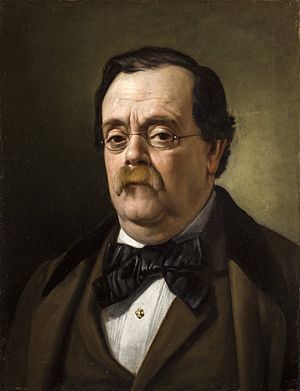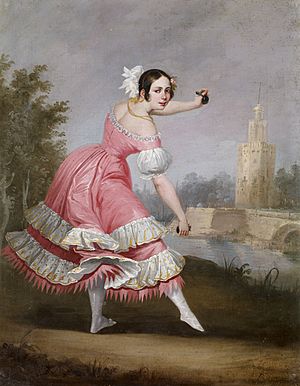Antonio Cabral Bejarano facts for kids
Quick facts for kids
Antonio Cabral Bejarano
|
|
|---|---|

Self-Portrait (1851)
|
|
| Born |
Antonio Joaquín María de Todos los Santos Ignacio de Loyola Quintín
15 October 1798 |
| Died | 1 August 1861 (aged 62) |
| Nationality | Spanish |
| Education | Joaquin Cabral Bejarano (his father) |
| Known for | Painting |
| Movement | Romantic painting Costumbrismo |
| Patron(s) | City Council of Seville, Duke of Montpensier |
Antonio Cabral Bejarano (born October 31, 1798 – died August 1, 1861) was a Spanish painter. He was known for his art style, which included both Romantic painting (a style popular across Europe) and Costumbrismo (a Spanish style showing everyday life and customs). Antonio came from a family of painters, and his father taught him how to paint. He mostly worked in his hometown of Seville, Spain. He received many jobs from the city government. He also became the first Director of the Museum of Fine Arts of Seville.
Contents
Antonio's Early Life
Antonio Cabral Bejarano was born in Seville, Spain. His family had many painters before him. His great-grandfather, Diego Bejarano, was a painter. Diego's daughter, Maria Bejarano, married Pedro Cabral. Their son, Joaquin Cabral Bejarano, was Antonio's father and a well-known painter.
In 1785, Joaquin married Escolástica Pérez Junquitu Fernández. Antonio was born to them in 1798. He was given a very long name at his baptism: Antonio Joaquín María de Todos los Santos Ignacio de Loyola Quintín. Later, he chose to use only his father's last names, Cabral Bejarano.
Antonio's Painting Career
Antonio learned to paint from his father. In 1812, after French soldiers left Seville, art classes started again at the School of Three Noble Arts. Antonio joined as a student.
Early Art Projects
In 1814, Antonio worked with his father to decorate the convent of the Trinity. In 1816, they decorated the General Archive of the Indies. This building was also a court at the time. They did this special decoration because two Portuguese princesses, María Isabel de Braganza and Francisca de Braganza, were passing through Seville. They were on their way to Madrid to marry King Fernando VII and his brother, Carlos María Isidro.
In 1819, Antonio helped build a special funeral monument called a catafalque in the Cathedral of Seville. This was to remember Maria Isabel de Braganza, who sadly died after only two years of marriage. Antonio also made an engraving of the catafalque for a book about the event. In 1820, he designed decorations for the Seville city council to celebrate the Constitution of 1812.
Teaching and Important Commissions
In 1825, Antonio became an Assistant Professor of Perspective at the School of Three Noble Arts. Perspective is the art of drawing objects to show their depth and distance.
In 1829, the City Council of Seville asked him to build the "Temple of Himeneo" in a public square. This was to celebrate the marriage of King Fernando VII and María Cristina de Borbón.
In 1835, Antonio received an important appointment at the San Fernando Royal Academy of Fine Arts in Madrid. This was because of his painting called "The Decapitation of St. John the Baptist."
In 1837, he joined the management committee of the new Museum of Fine Arts in Seville. In 1838, he helped organize events and art shows for the Liceo de Sevilla, an art and culture group. In 1839, the Seville City Council asked him to create another temporary monument, the "Temple of Peace." This celebrated the end of the Carlist War.
Leading the Museum and School
In 1840, Antonio Cabral Bejarano was named the first Director of the Museum of Fine Arts of Seville. This was a very important job!
In 1846, he designed decorations for the Civil Government building's front. This was for the weddings of Queen Isabel II and her sister Luisa Fernanda. He also designed the front of the Theater of the Passion that year. In 1847, he painted the stage decorations and ceilings for the San Fernando Theater.
In 1850, he became the director of the School of Fine Arts in Seville. Between 1850 and 1857, he created many artworks for the Duke of Montpensier. These included paintings for the chapel of the Palace of San Telmo and portraits of famous people from Seville. Another painter, Joaquín Domínguez Bécquer, took over his role at the palace later.
In July 1853, there was a misunderstanding when he was accused of selling fifty paintings from the Museum of Fine Arts. He was removed from his job as director. However, he was readmitted in September after he showed that the paintings were still there.
Antonio's Family Life
In 1823, Antonio married Francisca de Paula Aguado Pacheco. They had many children: Francisco (born 1824), Jose Maria (1826), Manuel (1827), Carlota (1829), María Dolores (1832), Juan Antonio (1834), Rafael (1837), María Aurora (1838), and Luisa (1840). All his children used the last names Cabral Bejarano. Several of them also became painters, following in their father's footsteps!
Antonio's Passing
Antonio Cabral Bejarano died in Seville when he was 62 years old.
See also
 In Spanish: Antonio Cabral Bejarano para niños
In Spanish: Antonio Cabral Bejarano para niños


